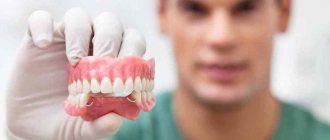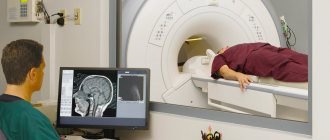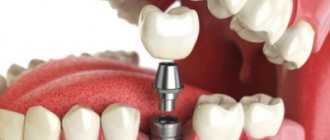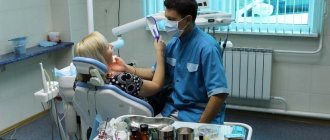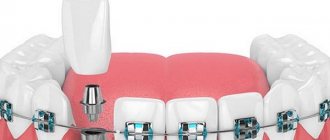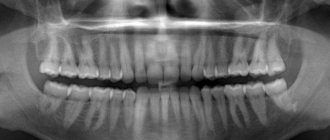- What is implantation
- Which doctor performs the procedure
- Indications and contraindications
- Features of the procedure
- Possible complications
- In conclusion
Modern dentistry now has enormous capabilities not only for treatment, but also for dental restoration. Among dental procedures, the installation of implants now occupies a leading position. Many people think about this operation, but most have questions: who does dental implantation and what are the features of the procedure. Such information is necessary in order to avoid receiving poor-quality services and possible further complications when choosing dentistry (often arise if implantation is carried out by an unqualified specialist).
What is implantation
People who have not previously encountered implantation have somewhat generalized information about this dental procedure. The installation of implants is often mistakenly mistaken for prosthetics. However, these are mini-operations, despite the similar goals, dental restoration is a completely different procedure.
Implantation is a dental operation to insert a pin or, as they are correctly called, an implant into the jaw tissue (in place of a missing tooth). In the future, the pin will replace the root, on which a structure will be installed to replace the tooth.
The operation has many features, one of which is the absence of the need for your own bone and jaw tissue. Unlike prosthetics, this method is used even in severe cases of dental pathologies.
The success of the procedure largely depends on which doctor installs the dental implants. If a specialist makes mistakes, serious complications are possible that require immediate treatment.
Basic methods of orthodontic treatment
Without knowing what exactly the patient came with, it is impossible to say what the orthodontist will do , because the methods of influence primarily depend on the problem and defects in the dentition. Sometimes you can get by with minimal interventions, in other cases you need to involve a dental surgeon.
The most popular methods of dental orthodontism are myotherapy or myogymnastics, hardware treatment and surgical intervention. It is rare that these methods are used in their “pure” form; usually the doctor combines them, forming the course of treatment necessary for a particular patient.
Myotherapy
Myotherapy is one of the ways to strengthen the muscles of the maxillofacial area, thanks to which the formation of anomalies in childhood can be avoided. Based on theoretical calculations about orthodontic treatment, we can conclude that this is the safest and least effective method. Therefore, myogymnastics is almost never prescribed separately.
During classes, the child needs to perform two types of exercises:
- dynamic, when the muscles of the face and jaw sometimes tense and then relax;
- static, forcing the organs to be in tension all the time.
Considering that the exercises must be systematic, classes require adult supervision. Also, it is the parent or teacher who checks that the tasks are completed correctly, because the child may forget or not understand the doctor. The specialist selects tasks, then teaches the adult the exercises, then the adult checks the child.
Myogymnastics class in a children's group: warm-up
Hardware method
The frequency of use of the method clearly shows: an orthodontist is a doctor who treats with fixed and removable hardware systems. The most famous of them are braces, mouth guards and trainers, and plates. When installed, they act on individual teeth, causing them to slowly but surely move in the desired direction. As a result, all elements of the oral cavity occupy their intended position.
Treatment with devices has certain limitations. So, corrections are possible if:
- sufficient force is applied to the tooth, i.e. the equipment is assembled correctly and installed correctly;
- the device has a reliable support and is well fixed;
- there is a place in the dentition into which a stray element can fit;
- there are no obstacles in the path of the tooth being moved.
If these rules are not followed, the dental orthodontist corrects this , and then installs braces, plates or other devices. Sometimes it takes a lot of time to prepare, because it is necessary to remove excess teeth and wait for the restoration of the oral cavity.
Surgical method
If the diagnosis shows that the deformation of the development of the dental arches, jaws or malocclusion is too pronounced, it is necessary to resort to surgical methods. The most popular types of surgical intervention:
- exposure of the crown of an impacted tooth (i.e., removal of the upper gum tissue above a tooth that has not erupted correctly);
- rotation of the tooth around its axis, as a result of which the element falls into place in the dentition correctly;
- removal of individual teeth of irregular shape, extra teeth, as well as those that cannot be “fitted” into the jaw for some reason, etc.
In some situations, surgical intervention falls under the purview of what an orthodontist does . If the specialist cannot correct the situation on his own, he gives the person a referral to a dental surgeon.
Which doctor performs the procedure
In the majority, people believe that a dentist is a generalist doctor who alone performs absolutely any procedure in this field of medicine. This is not at all true; in dentistry there are several areas where doctors of a certain specialization work.
Of course, one doctor can have several specialties, however, for example, to perform surgical operations (including implantation) requires appropriate qualifications.
So who puts implants? Which specialist should you contact if you need a service?
The first appointment is most often carried out by a dentist in the therapeutic department to determine the indications and prescribe diagnostics. If the patient has no contraindications, and the need for implantation is confirmed, then a day of surgery is scheduled, which will be performed by a doctor with experience in installing implants and prosthetics. Which doctor performs dental implants? Popularly, such a doctor is called an implantologist; in medicine, a surgeon or orthopedist.
Indications and contraindications
Implantation cannot be performed at the first visit, only at the request of the patient. In order to install implants, the dentist must confirm the indications for surgery.
Indications include pathologies of the dentition or jaw bones:
- missing one tooth;
- absence of 2 or more dental organs, with adjacent location;
- absence of the last teeth without the possibility of restoration by other methods;
- complete edentia (congenital pathology characterized by the absence of teeth);
- the presence of reasons preventing the wearing of a removable denture (for example, a gag reflex);
- pain caused by functional occlusion;
- absence of alveolar processes in the upper jaw with concomitant complete absence of teeth;
- anatomical defects that arise as a result of diseases, mechanical effects, as well as as a result of disturbances during intrauterine development or genetic predisposition.
In implantology, each case is necessarily considered taking into account the individual characteristics of the dental composition and jaw structure of each patient. An implant can be placed only after diagnosis. A qualified specialist will not carry out the procedure without a preliminary examination.
Contraindications
Diagnostics are necessary not only to confirm the indications, but also to determine the possible presence of contraindications to implantation.
Absolute contraindications for which implants should not be installed include diseases and pathological conditions:
- severe diseases of the cardiovascular system;
- malignant oncological diseases;
- diseases of the nervous system;
- blood pathologies (especially poor clotting);
- severe connective tissue diseases;
- open tuberculosis;
- liver/renal failure during exacerbation;
- increased tone of the masticatory muscles in combination with bruxism;
- diabetes mellitus;
- immunodeficiency diseases;
- allergic reaction to painkillers;
- addiction to drugs or alcohol.
Implantation is not carried out for women carrying a child, as well as for children under 18 years of age. Fixed dentures are not installed until the age of 22. This is due to the fact that until the age of 22, a person’s jaw continues to grow and form. Between the ages of 22 and 25, surgery is performed only for serious indications.
When to contact an orthodontist
A child should learn who an orthodontist is before the age of 7. At this age, the permanent bite of the anterior incisors is still forming, so it is possible to stop some problems relatively painlessly. Most leaflets for parents contain the following recommendations for visiting a doctor:
- The child is one year old and parents have questions. What does an orthodontist do when the baby has no teeth yet? He examines whether the lips and those teeth that have already erupted are closing correctly;
- child is 3 years old. A visit is advisable, because at a young age, the prerequisites for incorrect development of teeth and jaws can be identified. Therefore, during such an appointment, the orthodontist always asks the parents whether the baby has bad habits, for example, sucking a pacifier, finger, tongue;
- the child has difficulty swallowing, chewing, and speech is not formed;
- you see that the child has changes in the position of the teeth or their closure.
Knowing what an orthodontist does , you can visit a specialist in advance to prevent problems in the development of the dentition and avoid their deterioration.
Features of the procedure
Implantation is performed in several stages, which the patient is recommended to inquire about in advance. Depending on the type of procedure and type of implants, the operation can be performed in one step, or it can stretch over several stages, which will take up to six months. If long-term treatment is expected, temporary structures and crowns are installed.
Types of implants
Dentistry offers several options for implants. However, they are all made of the same titanium. This material is considered the most reliable and safe. All products are divided into several types according to design and shape. Depending on the indications, the most suitable installation option is selected. In addition to indications, the choice of implant model is also influenced by their cost. Modern designs tend to be more expensive, but more convenient and durable.
By type of design:
- collapsible
- non-separable.
According to the shape of the products:
- lamellar - screwed into the bone tissue under the palate;
- root-shaped - installed in root canals;
- combined - placed in the root canal.
The clinic’s specialists are qualified and experienced in installing any type of implants. The dentist will recommend which type of implants is suitable, based on the patient’s indications and wishes.
Installation Methods
The A-Medic clinic is equipped with exclusively modern technology, which allows us to perform all types of dental implantation. Implantologists have sufficient experience to solve problems even with complex dental pathologies.
Surgical dentistry, depending on the characteristics of the jaw, offers three options for dental implantation:
- basal - an inexpensive and quick method that allows you to install implants, and even more than one, immediately after tooth extraction;
- intraosseous - a method recommended after bone grafting;
- laser - a low-traumatic operation, possible only if the bone is preserved with a height of at least 6 mm;
- subperiosteal - an implantation method used when the patient lacks bone tissue (does not require additional bone augmentation);
- transgingival - a minimally invasive technique is used to open the gum tissue to install one or more products;
- endodonto-endosseous - the pin is inserted into the canal (the gum is not cut), allowing the root to be preserved;
- intramucosal - used in the absence of intraosseous implantation, suitable for increasing the fixation rates of removable dentures;
- transosseous - recommended for atrophy of the soft and bone tissues of the lower jaw;
- Express - implantation - temporary introduction of an implant and a temporary crown.
The dental clinic performs operations for both partial restoration of dental organs and turnkey dental implantation. You can read reviews about the results of the specialists’ work on the company’s website and on third-party sites.
How to remove dental crowns -
Unfortunately, we must also note the fact that sometimes situations arise when the crown needs to be removed. For crown removal, the price for 2021 will be about 1000 rubles per unit. The need to remove the crown may be due to the following reasons...
- With poor preparation of the tooth for a crown - according to statistics, in 60-70% of cases, the root canals of the teeth are filled poorly, which leads to the development of inflammation and the need for re-treatment or removal of the tooth. You can find out more about poor-quality preparation of teeth for prosthetics, what this leads to, and what to do about it here .
- With manufacturing errors - for example, the crown did not fit tightly around the neck of the tooth, and therefore, within days, the destruction of the tooth tissue began. Metal-ceramics or metal-free ceramics could chip a large fragment of the ceramic mass, which may not be repairable and require replacement of the crown (24stoma.ru).
- Scheduled replacement of crowns is necessary - all crowns have their own service life, and they will have to be changed periodically. It should be noted that high-quality modern crowns can last 8-10 years, or even more.
Removing crowns: video
And here the question always arises: does it hurt to remove the crown... It can indeed be a little painful, and therefore the procedure is performed under local anesthesia. Removing cermets, for example, is very difficult. The crown is sawed using special discs and burs, and cases of damage to the gums next to the tooth are not uncommon. We hope that the article on the topic: How to put crowns on teeth was useful to you!
Sources:
1. Personal experience as a dentist, 2. “Orthopedic dentistry. Textbook" (Trezubov V.N.), 3. National Library of Medicine (USA), 4. "Orthopedic treatment with fixed prostheses" (Rozenstiel S.F.), 5. "Crowns and bridges in orthopedic dentistry" (Smith B .).
Possible complications
Dental implants are a foreign material for the body, so the risk of complications can never be excluded. Modern product installation methods and techniques can minimize this risk as much as possible.
Possible complications:
- seam divergence;
- severe pain for more than three days;
- formation of hematomas;
- the appearance of bleeding;
- development of soft tissue inflammation.
Such complications are rather exceptions that arise due to compliance with the doctor’s advice on care during the rehabilitation period.
Somewhat more often, implant rejection and inflammation of the bone and gum tissue near the implant occur. The cause of inflammation can be insufficient oral care or violation of doctor’s recommendations. Implant rejection is an individual reaction of the body. The result is also influenced by which doctor places the dental implants. A qualified specialist will not make mistakes during the operation, and will monitor the patient’s condition throughout the entire rehabilitation in order to take timely measures and prevent complications.
In conclusion
Many people believe that installing implants is harmful to the body, since serious complications are possible. However, we should not forget that the absence of teeth also negatively affects health, since in addition to aesthetics (smile), a person’s teeth also perform a certain function (chewing food). The absence of certain teeth leads to a decrease in self-esteem, which affects a person’s psycho-emotional state, as well as problems with the gastrointestinal tract, since food is not chewed thoroughly enough.
You should not delay your visit to the doctor, assuming that implantation will cost too much or that it is not necessary. Of course, this is not a cheap service, but the result is worth the money spent.
